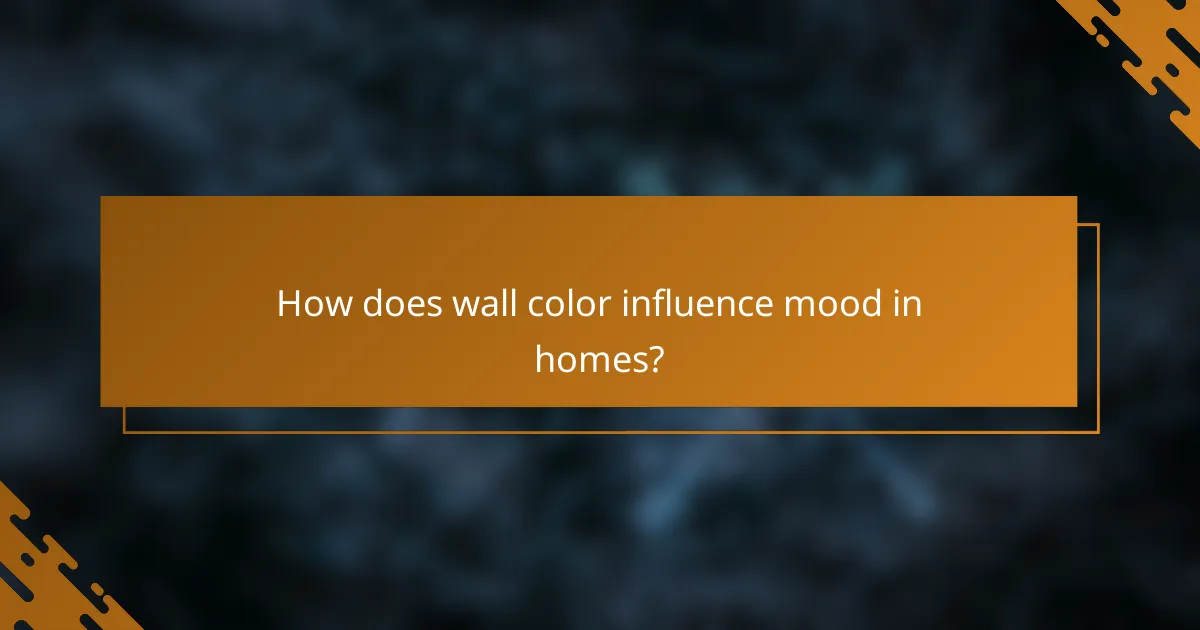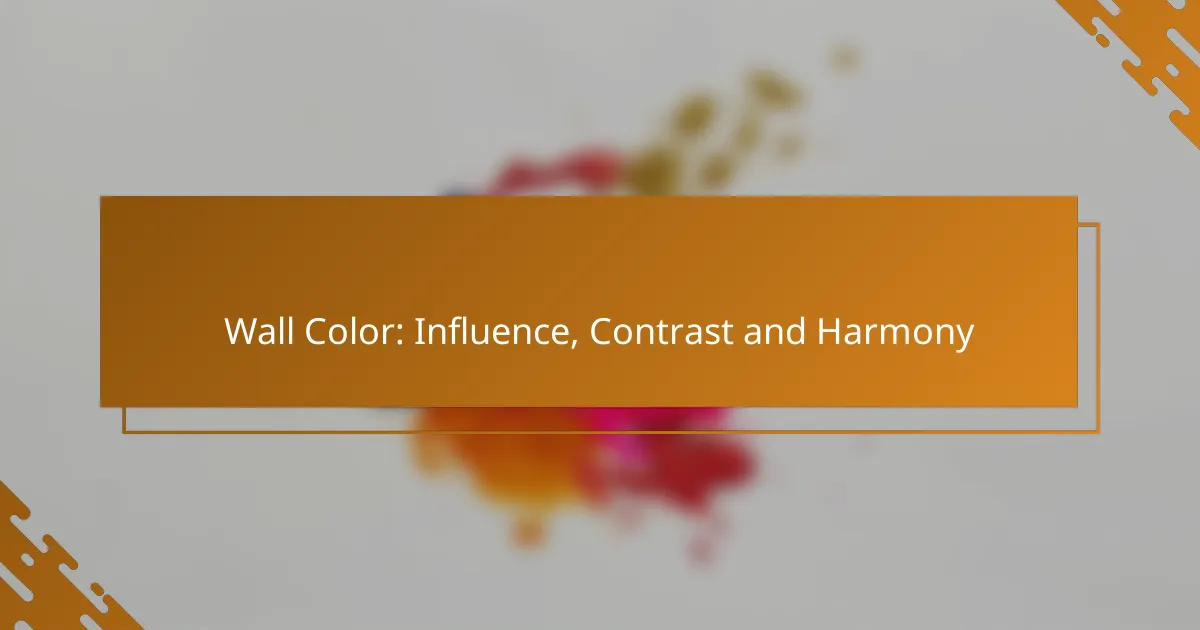Wall color plays a pivotal role in shaping the mood and atmosphere of a space, influencing emotions and perceptions. By carefully selecting colors, one can create a desired ambiance, whether it be calming or energizing. Additionally, effective color combinations can enhance contrast and visual interest, while lighter shades can make small areas feel more open and inviting.

How does wall color influence mood in homes?
Wall color significantly impacts mood by affecting emotions and perceptions within a space. Different colors can evoke various feelings, making the choice of wall color crucial for creating the desired atmosphere in a home.
Warm colors create energy
Warm colors like red, orange, and yellow are known to stimulate energy and enthusiasm. These hues can make a room feel more inviting and lively, which is ideal for social spaces such as living rooms and kitchens.
When using warm colors, consider the intensity and saturation. Bright, bold shades can create a vibrant atmosphere, while softer tones can add warmth without overwhelming the senses. A common approach is to use warm colors as accents in furniture or decor to balance energy levels.
Cool colors promote calmness
Cool colors such as blue, green, and purple are associated with tranquility and relaxation. These shades can help create a serene environment, making them perfect for bedrooms and bathrooms where peace is essential.
To enhance the calming effect, opt for lighter shades of cool colors. For instance, soft blues or pale greens can open up a space and promote a sense of spaciousness. Avoid overly dark cool colors, as they may create a somber mood instead of a soothing one.
Neutral colors enhance versatility
Neutral colors like beige, gray, and white provide a versatile backdrop that can adapt to various styles and moods. These colors allow for easy integration of different decor elements and can make spaces feel more spacious and airy.
When selecting neutral colors, consider the undertones—warm or cool—as they can influence the overall ambiance. Pairing neutrals with vibrant accents can create a balanced look, ensuring the space remains dynamic without becoming chaotic. Neutral tones are particularly effective in open-concept areas where cohesion is key.

What are the best wall color combinations for contrast?
The best wall color combinations for contrast involve using colors that are opposite each other on the color wheel, creating a vibrant and dynamic look. These combinations enhance visual interest and can dramatically change the perception of a space.
Complementary colors for striking contrast
Complementary colors are pairs of colors that sit opposite each other on the color wheel, such as blue and orange or red and green. When used together, they create a bold and eye-catching effect, making each color appear more vivid. This approach is ideal for spaces where you want to make a statement or draw attention to specific areas.
To effectively use complementary colors, consider painting one wall in a bold hue while keeping adjacent walls in a neutral tone. This balance allows the complementary colors to pop without overwhelming the space.
Analogous colors for subtle harmony
Analogous colors are those that are next to each other on the color wheel, such as blue, blue-green, and green. These combinations provide a more cohesive and serene look, making them suitable for spaces meant for relaxation, like bedrooms or living rooms. The gentle transition between colors creates a sense of unity and calm.
When using analogous colors, choose one dominant color and use the others as accents. For example, a soft blue wall can be complemented with blue-green decor to maintain harmony while still adding depth.
Monochromatic schemes for depth
Monochromatic color schemes involve using variations of a single color, including different shades, tints, and tones. This approach can create a sophisticated and layered look, adding depth without the distraction of contrasting colors. It works well in modern and minimalist designs.
To implement a monochromatic scheme, select a base color and then incorporate lighter and darker versions of that color through paint, furniture, and accessories. This technique can make a room feel more expansive and cohesive.

How to choose wall colors for small spaces?
Choosing wall colors for small spaces involves selecting hues that create an illusion of openness and brightness. Light and neutral shades are often preferred, as they can make a room feel larger and more inviting.
Light colors to expand perception
Light colors, such as whites, creams, and pastels, can significantly expand the perception of space in smaller rooms. These shades reflect more light, which helps to create an airy atmosphere. Consider using a soft white or a pale blue to enhance the feeling of openness.
When selecting light colors, aim for those with warm undertones to avoid a sterile look. For example, a warm beige or a soft lavender can add warmth while still keeping the space feeling expansive.
Accent walls to create focal points
Accent walls can effectively create focal points in small spaces without overwhelming them. By painting one wall a bolder color, you draw attention to that area, which can make the room feel more dynamic. Choose a color that complements the lighter shades used on the other walls.
When implementing an accent wall, consider using colors like deep navy or forest green, which can add depth. Ensure that the accent color harmonizes with the overall color scheme to maintain a cohesive look.
Reflective finishes to enhance light
Using reflective finishes, such as satin or semi-gloss paint, can enhance light in small spaces. These finishes bounce light around the room, contributing to a brighter and more open feel. Consider applying these finishes to both walls and trim for a unified effect.
Keep in mind that while reflective finishes can brighten a space, they may also highlight imperfections on the walls. Proper surface preparation is essential to achieve the best results, so ensure walls are smooth and well-maintained before painting.

What are the latest trends in wall colors for 2024?
In 2024, wall color trends emphasize a blend of natural elements, bold statements, and soft aesthetics. Homeowners are gravitating towards colors that evoke feelings of comfort, elegance, and tranquility.
Earth tones for a natural feel
Earth tones are increasingly popular, providing a warm and inviting atmosphere. Shades like terracotta, olive green, and muted browns create a connection to nature, making spaces feel grounded and serene.
When selecting earth tones, consider using them in living areas or bedrooms to promote relaxation. Pair these colors with natural materials like wood and stone for a cohesive look.
Bold jewel tones for dramatic impact
Bold jewel tones, such as emerald green, sapphire blue, and ruby red, are making a statement in modern interiors. These rich colors can add depth and sophistication to any room, especially when used as accent walls.
To effectively incorporate jewel tones, balance them with lighter shades or neutral furnishings. This contrast helps prevent overwhelming the space while still showcasing the vibrancy of the colors.
Pastels for a soft aesthetic
Pastel colors remain a favorite for those seeking a gentle, airy feel in their homes. Soft hues like blush pink, mint green, and baby blue can create a calming environment, perfect for bedrooms or nurseries.
Combining pastels with white or light wood accents enhances the overall softness. Be mindful of using too many pastel shades together, as this can dilute the calming effect and make the space feel less cohesive.

How does lighting affect wall color perception?
Lighting significantly influences how we perceive wall colors, altering their appearance based on the type and intensity of light. Natural light tends to reveal the true colors, while artificial lighting can distort them, leading to unexpected results in interior design.
Natural light enhances true color
Natural light, particularly sunlight, provides a full spectrum of illumination that showcases the authentic hues of wall paint. During different times of the day, sunlight can change in intensity and color temperature, affecting how colors are perceived. For instance, morning light may cast a warm glow, while afternoon light can appear cooler.
To maximize the benefits of natural light, consider using lighter shades on walls, which can reflect sunlight and create a brighter atmosphere. Large windows and mirrors can also help distribute natural light throughout a room, enhancing the overall color perception.
Artificial light alters color appearance
Artificial lighting, such as incandescent, fluorescent, or LED bulbs, can significantly change how wall colors are seen. Each type of bulb emits different color temperatures; for example, incandescent bulbs often produce a warm yellow light, while fluorescent lights can appear cooler and more bluish. This can lead to a mismatch between the intended color and what is actually seen.
When selecting artificial lighting, it’s crucial to consider the color rendering index (CRI) of the bulbs. A CRI of 90 or above is ideal for accurately displaying colors. Testing paint samples under the intended artificial lighting can help avoid unpleasant surprises.
Lighting fixtures influence mood
The choice of lighting fixtures not only affects color perception but also sets the mood of a space. Warm lighting can create a cozy and inviting atmosphere, while cooler lighting can promote alertness and productivity. This is particularly important in areas like living rooms and offices where ambiance is key.
To achieve the desired mood, consider layering different types of lighting, such as ambient, task, and accent lighting. Dimmer switches can also provide flexibility, allowing you to adjust the brightness according to the time of day or activity, further enhancing the wall colors and overall environment.

What are the psychological effects of color in interior design?
The psychological effects of color in interior design significantly influence mood, perception, and behavior. Different colors evoke distinct emotional responses, which can enhance or detract from the intended atmosphere of a space.
Color psychology in branding
Color psychology plays a crucial role in branding by shaping consumer perceptions and influencing purchasing decisions. For example, blue often conveys trust and reliability, making it popular among financial institutions, while red can evoke excitement and urgency, frequently used in sales promotions.
Brands should consider their target audience when selecting colors. Cultural differences can affect color interpretation; for instance, white symbolizes purity in Western cultures but may represent mourning in some Eastern cultures. Understanding these nuances can help brands resonate more effectively with their audience.
Color impact on productivity
The impact of color on productivity is well-documented, with certain hues enhancing focus and creativity. For instance, blue tones are known to promote calmness and concentration, making them suitable for workspaces, while yellow can stimulate creativity and innovation.
To optimize productivity, consider the function of each space. For collaborative areas, warm colors like orange can foster energy and teamwork, while cooler shades in individual workspaces can help maintain focus. Balancing color use across different environments can create a harmonious and efficient workspace.



